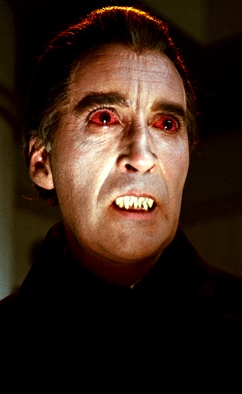V Is for Vampires & Energy Drain
For as long as I can remember, the World’s Most Popular Roleplaying Game has included energy drain as a special attack for various monsters, especially certain iconic undead such as vampires. Regardless of edition, energy drain invokes fear from players as well as a degree of frustration from everyone since the mechanics have often been cumbersome.
The Pathfinder Roleplaying Game defines energy drain’s game effects as follows:
This attack saps a living opponent’s vital energy and happens automatically when a melee or ranged attack hits. Each successful energy drain bestows one or more negative levels (the creature’s description specifies how many). If an attack that includes an energy drain scores a critical hit, it bestows twice the listed number of negative levels.
Unless otherwise specified in the creature’s description, a draining creature gains 5 temporary hit points for each negative level it bestows on an opponent. These temporary hit points last for a maximum of 1 hour.
For each negative level a creature has, it suffers the following:
* A cumulative -1 penalty on all ability checks, attack rolls, combat maneuver checks, Combat Maneuver Defense, saving throws, and skill checks.
* In addition, the creature reduces its current and total hit points by 5 for each negative level it possesses.
* The creature is also treated as one level lower for the purpose of level-dependent variables (such as spellcasting) for each negative level possessed. Spellcasters do not lose any prepared spells or slots as a result of negative levels.
* If a creature’s negative levels equal or exceed its total Hit Dice, it dies.Negative levels remain until 24 hours have passed or until they are removed with a spell such as restoration. If a negative level is not removed before 24 hours have passed, the affected creature must attempt a Fortitude save (DC 10 + 1/2 the draining creature’s racial HD + the draining creature’s Cha modifier; the exact DC is given in the creature’s descriptive text). On a success, the negative level goes away with no harm to the creature. On a failure, the negative level becomes permanent. A separate saving throw is required for each negative level.
A Problem: Energy Drain & Sameness

The core rules for energy drain do an adequate job of making energy-draining monsters fearsomer, but the rules themselves lack something I as a GM desire, namely variety. Other than differing save DCs and differing numbers of negative levels inflicted, all energy drain is pretty much the same. This seems a shame. After all, there isn’t just one type of poison or disease, even though almost all poisons and diseases use the same basic mechanics.
Feeling the lack of energy drain variety unacceptable, I said to myself, “Self, let’s see if we can ‘fix’ this ‘problem’.”
A Solution: Energy Drain as Inflicted Conditions
To use these optional rules, you don’t have to change the energy-draining monster. Use the same save DC, the same attack mode, and the same number of negative levels inflicted. Instead of using the energy drain rules explained above, give these are whirl.
Each negative level inflicts a condition. Additional negative levels increase the severity of the effect. Conditions are tracked by degree of severity, and can be immediately resisted by a saving throw. Degrees of severity (DoS) above the first DoS fade after 1 round per Hit Die of the inflicting monster, but the first DoS remains and the higher degrees may reassert themselves under the right conditions.
The inflicting monster still benefits from condition-causing energy drain as outlined above. Thus, the monster gains 5 temporary hit points for each negative level it bestows on an opponent. These temporary hit points last for a maximum of 1 hour.
To get a grip on what this means, let’s look at one increasing scale of conditions:
Fear Condition Degrees of Seriousness
| 1st Degree | 2nd Degree | 3rd Degree | 4th Degree |
|---|---|---|---|
| shaken | frightened | panicked | cowering |
Now imagine your PCs are facing a vampire spawn. This is a 4 Hit Die monster that inflicts one negative level with a 14 save DC. This particular vampire spawn, however, doesn’t actually inflict negative levels. Instead, it inflicts fear conditions of increasing severity.
Combat starts, the vampire hits a PC, and the PC must make a DC 14 Fortitude save. The PC fails the save, becomes shaken for 4 rounds, and the vampire spawn gains 5 temporary hit points. Another round starts. The PC is hit again, fails the Fortitude save again, and is now frightened for 4 rounds. The vampire spawn is defeated despite the 10 temporary hit points it gained. The PC is no longer frightened, but he remains shaken.
Now here’s where things get interesting. The PC stays shaken until 24 hours have passed or until the shaken condition is removed with an appropriate spell. (I recommend the spell be of at least 4th level even if you don’t opt to let restoration work.) If the shaken condition is not removed before 24 hours have passed, the PC must attempt another DC 14 Fortitude save. On a success, the shaken condition goes away with no harm to the PC. On a failure, the shaken condition becomes permanent (albeit only in the sense that it now requires magic to dispel, as mentioned above).
What’s worse, as long as the PC remains shaken, he is more vulnerable to fear effects. Should the PC be affected by any effect that inflicts a fear condition, he automatically gains the fear condition that is equal to highest DoS caused by the energy-draining creature (unless the fear-causing attack would normally inflict a more serious condition).
Imagine our shaken PC. The vampire spawn encounter is over and done with, but he still can’t pull himself together. A gnawing dread nibbles at the fraying edges of his imagination. Several hours later, the PC is still shaken when he encounters a hill giant. The hill giant uses Intimidate to demoralize the PC and succeeds. Normally, this would cause the PC to become shaken, but he’s already shaken. Instead, he automatically becomes frightened, since this was the highest DoS inflicted by the vampire spawn.
DoS for Other Conditions
With some thought (and descriptive refluffing where necessary), energy drain could inflict other conditions with varying DoS. For example:
Fatigue Condition Degrees of Seriousness
| 1st Degree | 2nd Degree | 3rd Degree |
|---|---|---|
| fatigued | exhausted | unconscious |
Lethargy Condition Degrees of Seriousness
| 1st Degree | 2nd Degree | 3rd Degree |
|---|---|---|
| entangled | staggered | paralyzed |
The fatigue condition DoS represents energy drain that saps physical vitality. An affected PC is winded as from great exertion, and more susceptible to effects that cause fatigue. The lethargy condition DoS simulates energy drain making a PC’s movements slower. The entangled condition doesn’t prevent movement, but has its other normal effects, which are that the entangled creature moves at half speed, cannot run or charge, and takes a -2 penalty on all attack rolls and a -4 penalty to Dexterity. Also, an entangled character who attempts to cast a spell must make a concentration check (DC 15 + spell level) or lose the spell.
When using monsters that inflict more than one negative level with an attack (such as vampires and spectres), consider combining the core rules with these optional rules. A vampire that inflicts both a negative level and forces a Fortitude save to resist fatigue condition DoS presents a different threat than players would normally expect.
And how could shaking up too comfortable players be a bad thing?


Leave a Reply